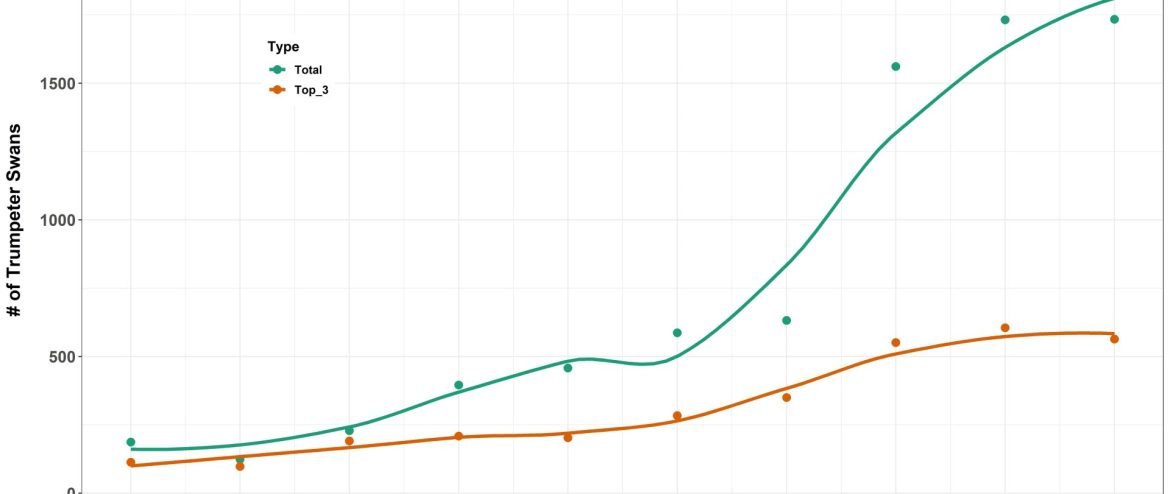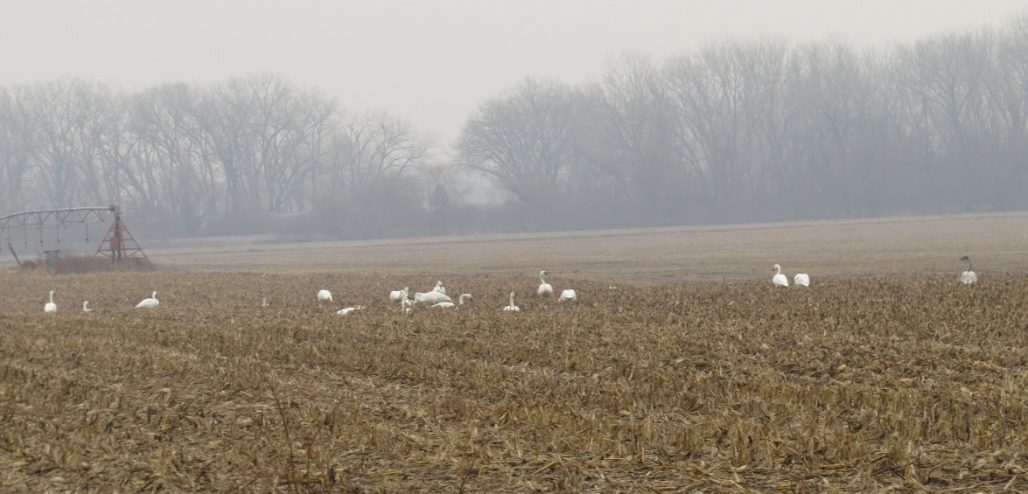Trumpeter Swans appear to have become much more numerous during winter in Nebraska in recent years. Thus, there is a need to quantify this perceived increase to determine whether this is indeed the case. Furthermore, looking at the data will hopefully reveal the sources of the increased numbers of Trumpeter Swans. This post is an attempt to look at the most recent available data in order to answer these questions.
Trumpeter Swans have indeed increased, rather stunningly. The number of Trumpeter Swans wintering (Dec-Feb) in Nebraska is shown in Figure 1; the numbers graphed are the total number of Trumpeter Swans reported to eBird (eBird.org “Species Maps”; accessed 22 Feb 2023) for each winter, avoiding where possible duplicated counts. Table 1 includes the count data used to produce Figure 1. To avoid bias related to increasing numbers of eBird observers and the tendency of birders reporting numbers at wintering locations where swans can be reliably found, we only used the three highest counts reported each winter. Note the totals of “top three counts” each year essentially mirror the trend as total number of Trumpeter Swans reported per winter.


Trumpeter Swans have become a major conservation success story as numbers in North America have increased exponentially in recent decades (Baldassarre 2014). Until the 1980s, most Nebraska Trumpeter Swans were summer residents in the Sandhills and wintered at Lacreek NWR, South Dakota (Baldassarre 2014). The estimated number of resident Trumpeter Swans in Nebraska has increased from 200 individuals in 2000 to 311 individuals in 2015 (Groves 2017), with more recent surveys showing Nebraska may have more than 700 resident Trumpeter Swans (Mark P. Vrtiska, personal communication). Resident birds that breed and winter in western Nebraska are considered part of the High Plains population (Groves 2017). The increasing number of wintering birds in eastern Nebraska corresponds with increases in numbers of the reintroduced Interior population, which breeds as close as Iowa and Minnesota (Groves 2017). Increases in Iowa and Minnesota have been impressive, from an estimated 742 individuals in 2000 to an estimated 17,224 individuals in 2015 (Groves 2017), and recent surveys in Minnesota (Herberg and Rettler 2022) indicated a doubling of numbers of Trumpeter Swans from 11,450 in 2013 (Standard Error: 2517) to 25,110 in 2022 (SE 3033). Interestingly, Herberg and Rettler (2022) noted the 2022 Minnesota results indicated Trumpeter Swans have not yet saturated available aquatic habitat. As of winter 2022-2023, wintering Trumpeter Swans of the “Interior population” are concentrated in the Missouri River Valley and southward on the eastern Great Plains to Oklahoma and Arkansas, and those of the High Plains population occur in the western two thirds of Nebraska mostly in the Platte and North Platte river valleys (eBird.org “Species Maps” for “Dec-Feb all years”; accessed 22 Feb 2023).

Traditional Nebraska wintering sites, those before approximately 2010, were generally in western Nebraska, and consisted of High Plains Trumpeter Swans, but as numbers of the Interior population increased, sites in eastern Nebraska were occupied by increasing numbers of wintering Trumpeter Swans. Traditional western sites were Blue Creek in Garden Co, the Snake River in Cherry Co, portions of the Loup River system, and the North Platte River at Lake Ogallala, Keith Co (Rosche 1994; Ducey 1999, Vrtiska and Comeau 2009). However, as numbers have increased rapidly in the 2000s, flocks are being reported in the east at locations where open water is reliably available. Regular wintering locations include Carter Lake, Omaha, areas along the Platte River where birds may use both sandpit lakes and the river channel, and DeSoto NWR, Washington County, although numbers have declined at Carter Lake since 2017-2018. Wintering flocks appear away from the breeding range in late December and spring departure is completed by mid-February.
As of 2022, migration includes short distance movements of resident birds of the High Plains population and longer distance movements of birds of the Interior population, the latter extending south to Oklahoma and Arkansas. As a consequence, Trumpeter Swans have also become more numerous away from wintering sites during spring and fall migration. Trumpeters Swans are no longer unexpected at any lake or wetland in early spring or late fall.
Trumpeter Swans have shown a remarkable increase over the past decade and the increase shows no signs of abating. It seems plausible, if not likely, that congregations of Trumpeters Swans will continue to increase and new wintering sites will become established. It seems unlikely anyone will be upset about seeing more of these magnificent birds.
Literature Cited
Baldassarre, G. 2014. Ducks, geese, and swans of North America. Johns Hopkins University Press, Baltimore, Maryland, USA.
Ducey, J.E. 1999b. Trumpeter Swans in Nebraska Sandhills. Trumpetings 9: 2.
Groves, D.J. 2017. The 2015 North American Trumpeter Swan Survey. U.S. Fish and Wildlife Service Division of Migratory Bird Management, Juneau, Alaska, USA.
Herberg, A., and S. Rettler. 2022. Minnesota Breeding Trumpeter Swan Survey 2022. Minnesota Department of Natural Resources
Rosche, R.C. 1994. Birds of the Lake McConaughy area and the North Platte River valley, Nebraska. Published by the author, Chadron, Nebraska, USA.
Vrtiska, M.P., and S. Comeau. 2009. Trumpeter Swan survey of the High Plains flock, Interior Population winter 2008. Unpublished report, Nebraska Game and Parks Commission Lincoln, Nebraska, and U.S. Fish and Wildlife Service, Lacreek NWR, Martin, South Dakota, USA.